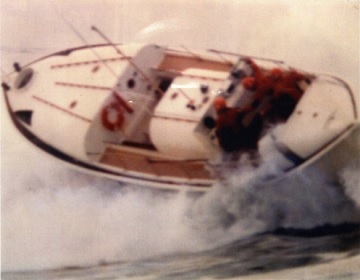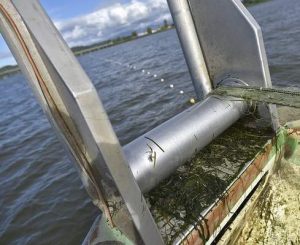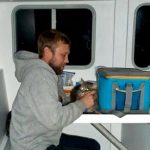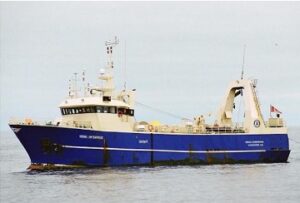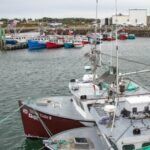A recent update to the state’s Columbia River salmon management policy to change harvest allocations and allow commercial gillnetting on the main stem has anglers reeling. “We’ve made a lot of changes over the last 30 years to how we fish in order to adjust to (federal Endangered Species Act) listings, in order to adjust to harvesting the best fish in the river at the best times,” said Robert Sudar, a commercial fishing advisor based in Longview. “It’s a totally different fishery than it was 30 to 40 years ago.” >click to read< 10:08
Tag Archives: Columbia River
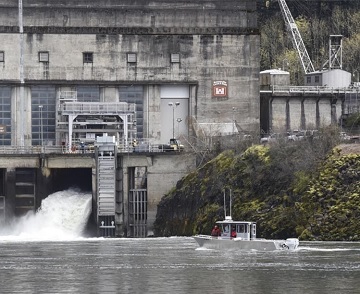
Sea lions threaten Northwest’s salmon – Pinnipeds eating thousands of at-risk fish in Columbia River
Decadeslong efforts by state and tribal agencies have slowly curbed sea lion populations in the region, yet officials still consider the pinnipeds a threat to at-risk salmon populations in the Columbia River. Between August 2021 and May 2022, officials estimate, more than 7,000 fish in the Bonneville Dam tailrace were killed by Columbia River sea lions, according to the Portland U.S. Army Corps of Engineers’ 2022 predation report. This totals about 12.4% of the salmon run accounted for during the agency’s observation period. Dozens of sea lions congregate at the dam in the fall, winter and spring. They feast on chinook, steelhead and coho salmon, as well as sturgeon and other fish. Spring chinook salmon were disproportionately affected, accounting for roughly 4,400 of the 7,000 fish killed. >click to read< 07:55

Coast Guard swimmer describes rescue of alleged Ore. yacht thief and ‘Goonies’ prankster
On the morning the U.S. Coast Guard in Astoria received a frantic mayday call from a yacht sinking near the treacherous mouth of the Columbia River, John “Branch” Walton was in his fifth and final day of advanced training as a rescue swimmer. Walton and his classmates leapt at the chance to respond. But it was a quick game of rock-paper-scissors that settled which swimmer would plunge into the churning, frigid waters nearby. Walton won. He was the least experienced of the bunch. Unbeknownst to the 22-year-old who learned to swim only after joining the Coast Guard a few years earlier, he’d soon execute a very difficult rescue seamlessly. And he would be thrust into the national limelight as millions viewed video of his first real-world rescue, taken from a camera mounted to the Coast Guard helicopter that flew him to the imperiled boater. >click to read< 10:29
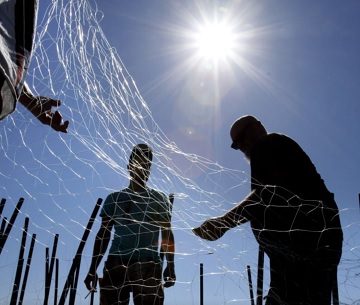
Days of gillnetting on lower Columbia River may be numbered
Senate Bill 5297 would remove nontribal mainstem gillnet use in the Columbia River downstream of Bonneville Dam to off-channel locations beginning in 2025. Tribal gillnetting in the Bonneville, The Dalles and John Day reservoirs would be unaffected by the bill. “It’s amazing to me that our state would be so incredibly inconsiderate in proposing such a thing,” said longtime gillnetter Irene Martin of Skamokawa. Martin argued that the legislation would jettison the Columbia River Interstate Compact, a bistate agreement between Washington and Oregon that manages commercial fishing on the lower Columbia River. >click to read< 12:44
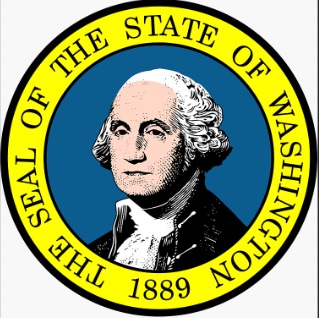
Letter: Columbia River Non-Tribal Gillnet Fishery Is No Threat to Recovery of ESA-Listed Salmon
Salmon management should be based on the best available science, but the efforts Sen. Wilson praises are not supported by the science. The commercial gillnet fishery harvests within all management guidelines, The non-tribal gillnet fishery in the lower Columbia is an important part of the cultural fabric of Washington state. It is a component of a commercial fishing industry that provides hundreds of year-round jobs in rural Washington and has for 150 years. Commercial fishermen were deemed “essential workers” during the pandemic because they harvest protein to feed residents of the Northwest and of the world and contribute substantially to Washington’s food security and the state economy. >click to read< By Robert Sudar, Longview 19:58
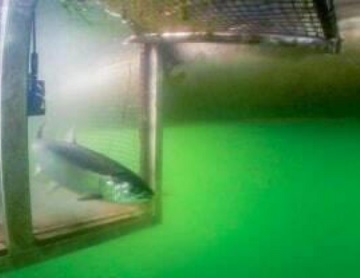
Commercial fish traps can aid wild salmon recovery
A new study evaluating alternative commercial fishing techniques further demonstrates the critical role commercial fish traps can play in recovering wild salmon and steelhead, improving fisheries management, and providing new sustainable fishing opportunities for coastal fishing communities. The publication confirms the ability of fish traps (or pound nets) to nearly eliminate unintended mortality of threatened salmon and steelhead encountered in commercial salmon fisheries of the Columbia River. >click to read< 18:09

Okanagan First Nation fishery celebrates record return of sockeye salmon
An estimated 670,000 sockeye have entered the Columbia River system this summer on a nearly-1,000-kilometre upstream journey toward spawning grounds in creeks and rivers, according to fish biologists with the ONA. More than 80 per cent of those fish are destined for Canadian waters near Osoyoos, B.C., in the south Okanagan, said Richard Bussanich, the organization’s head fish biologist. “This is a great story,” Bussanich said. “We’ve got more fish than spawning habitat coming back.” In partnership with Canadian and U.S. agencies, First Nations in the Okanagan have worked to restore the migration channels and re-introduce sockeye to the region over the past two decades, each year expanding spawning territory further into the valleys’ creeks and rivers. >click to read< 11:47
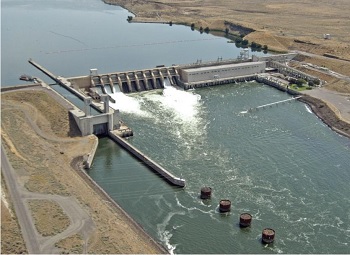
Report: Removing Lower Snake River dams – Bill filed to save Snake River dams.
If four Lower Snake River dams were breached to support salmon recovery, the energy, irrigation, recreation and other benefits they provide to the Pacific Northwest could be replaced for $10.3 billion to $27.2 billion, according to a draft report released Thursday by U.S. Sen. Patty Murray, D-Wash., and Washington Gov. Jay Inslee. The report does not take a position on whether the hydropower dams should be removed, but finds that breaching offers the best chance to recover salmon runs in the Columbia and Lower Snake rivers,,, >click to read<
Republican representatives, led by Rep. Dan Newhouse, R-Wash., introduced federal legislation on Thursday to protect the four lower Snake River dams from being breached. The bill was introduced just hours before a draft study commissioned by Sen. Patty Murray, D-Wash., and fellow Gov. Jay Inslee, a Democrat, was released. The draft study concluded that it would be costly, perhaps requiring more than $27 billion, but the dams could be breached and their benefits replaced. It would be the action most likely to restore endangered salmon runs and benefit tribes, the draft study said. >click to read< 10:52
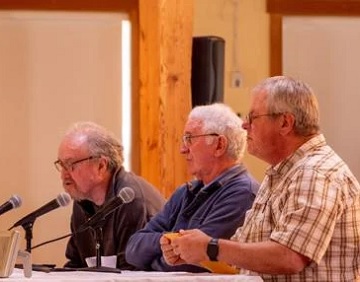
Fishermen urge Oregon Fish and Wildlife Commission to revisit regulations
Several local commercial fishermen have asked the Oregon Fish and Wildlife Commission to reconsider Columbia River fishing regulations. During the public forum section of the commission’s meeting in Astoria on Friday, commercial fishermen and those connected with the industry asked the commission to revisit gillnetting regulations and salmon buyback options. Jim Coleman, a fisherman from St. Helens, asked commissioners to add gillnetting to a future agenda or to work with Washington state to ensure the option of a 6-inch gillnet in the fall. “The gillnet-caught Copper River King salmon is flown from Alaska to Seattle on a chartered jet with great fanfare, demanding $70 to $80 a pound, while commercial fishing on the Columbia River is a political football,” >click to read< 12:18
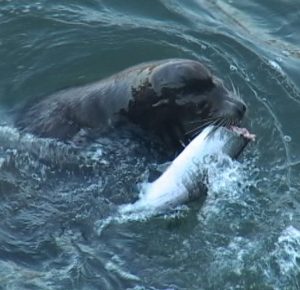
Salmon runs: Remove sea lions
Breaching the Snake River dams will not guarantee an improved salmon run. A better suggestion might be to remove the sea lions from the Columbia River and severely restrict fishing as our Canadian neighbors are doing for their Fraser River run. It is difficult for more salmon to get upstream when they are being overfished, and each sea lion consumes 15 to 40 pounds of fish per day. By John Crawford >click to read< 09:21
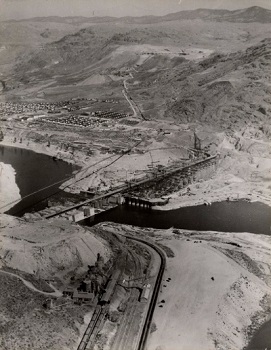
Flawed rescue? – Franklin D. Roosevelt asked for plans for a low dam. Joe Biden wants windmills
“The federal role in damming the Columbia tied in well with the New Deal belief that the government should stimulate economic recovery by putting people to work and encouraging the creation of public utilities,” records a National Park Service history of the river’s Grand Coulee dam. “Franklin D. Roosevelt, elected president of the United States in 1932, asked for plans for a low dam with foundations strong enough to support a higher dam later, one that would back water up to the Canadian border.” (President Joe Biden’s efforts to grow offshore wind) No thought was given to the river’s salmon. “Of all the impacts that caused extinctions of 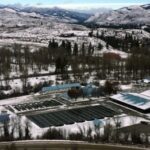 Columbia River Basin salmon and steelhead, dams were the most significant. “The dam wiped out runs that spawned in tributaries that drained into the Columbia from that point, river mile 596, to the headwaters, a distance of 645 river miles. Adding the tributary miles where salmon spawned nearly doubled the distance. >click to read< 14:36
Columbia River Basin salmon and steelhead, dams were the most significant. “The dam wiped out runs that spawned in tributaries that drained into the Columbia from that point, river mile 596, to the headwaters, a distance of 645 river miles. Adding the tributary miles where salmon spawned nearly doubled the distance. >click to read< 14:36
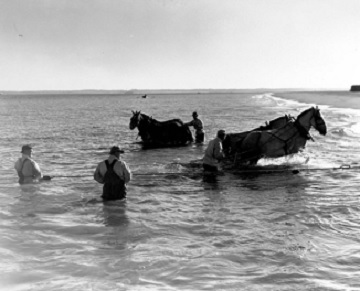
Commercial horse seining on the Columbia River
These days, the rotting pilings that sit in the middle of the Columbia River don’t seem like much at first glance. But they are the remnants of a booming cannery industry. Near the old Desdemona Sands Lighthouse, they were considered home for teams of horses that helped fishermen catch salmon along the river. Commercial horse seining on the Columbia River played a vital role in the area’s economy from the 1890s through the 1940s. When the river was in full swing, dozens of men would gather near Desdemona Sands and Sand Island to collect the bounty of salmon that awaited them. photos, >click to read< 14:20
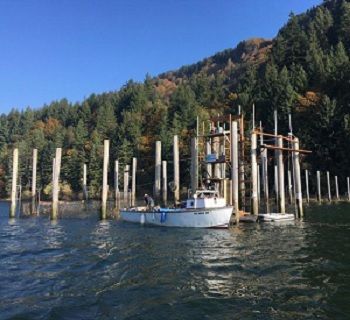
Washington State making a muddle of saving salmon
Local experts connected in various ways with salmon fishing and conservation must be ready to blow a gasket over the Washington Legislature’s latest clumsy efforts to “help.” In legislators’ defense, saving salmon is a supremely messy business, with more murky cross currents and furious undertows than a dangerous outer coast beach.,, Intentional confusion is added by outsiders whose only interest is in grabbing salmon for themselves or using the issue merely as a means to generate financial donations from well-wishing urbanites. And as if all that wasn’t enough, salmon management is also bound up with the need to help Washington’s endangered resident orcas, and with the obligation to coordinate some policies with Oregon and Canada. >click to read< 18:31
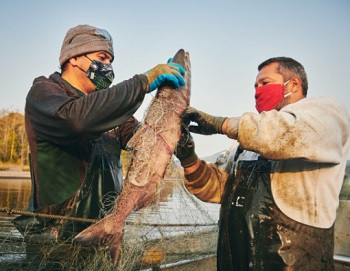
COVID-19 restaurant downturn, health risks pack double blow to tribal fishers, salmon business
On the 147-mile stretch of the Columbia from Bonneville Dam to McNary Dam, the only commercial fishing allowed is by the four Columbia Plateau tribes that signed treaties with the federal government in 1855. The treaties ensure the fishing rights of the Confederated Tribes and Bands of the Yakama Nation, the Nez Perce Tribe, the Confederated Tribes of the Umatilla Indian Reservation, and the Confederated Tribes of the Warm Springs Reservation of Oregon. Despite those treaties, dwindling salmon runs have forced the tribes to strike a delicate balance between their rights to the salmon, other commercial and recreational fishers, and protecting the environment. >click to read< 14:25

Sea lions take big bite out of early salmon runs
Early runs of wild spring Chinook salmon returning to the Columbia River are bearing the brunt of sea lion attacks, a new study suggests. The fish arrive in early spring before sea lions have left for summer breeding grounds and when the pinniped population is especially high at the river’s mouth. These salmon see higher mortality rates compared to later runs and the numbers have started to climb even over prior years, corresponding with a growing number of sea lions recorded near Astoria. >click to read< 08:56
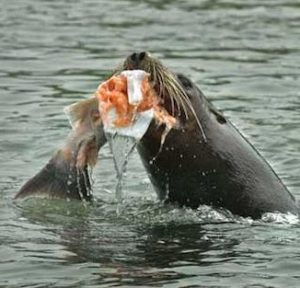
Federal officials approve Steller and California sea lions kill program along the Columbia River
As expected, federal officials on Friday approved a program to kill more than 700 sea lions along a nearly 200-mile stretch of the Columbia River and its tributaries in an effort to protect salmon at risk of extinction. The program is a significant step-up in existing efforts, and will be in place for five years. Targeted are both Steller and California sea lions, which will be darted with lethal levels of tranquilizing drugs by authorized teams from states and tribes. >click to read< 14:13
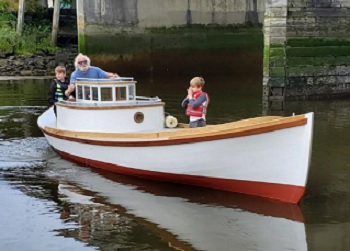
Historic fishing boat gets another chance – “an incredible piece of our region’s maritime history”
Kent Craford’s wife used to joke that she’d probably have to bury him in the old gillnet boat he bought on a whim when they were young and broke and that for years his children called “the rusty boat.” Many people’s boat dreams have sunk at the dock — to the despair of marina managers everywhere. But not the John M, Craford’s 113-year old wooden fishing boat. Yes, it nearly sank one day in 2010 when the pump failed and rainwater filled it. That was a turning point. >click to read< 07:55
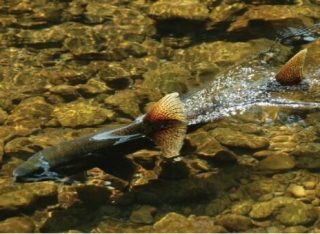
Columbia River Salmon Rules Set
The directors of the Washington and Oregon departments of Fish and Wildlife reached an agreement this week on allocations and gear types for Columbia River salmon fisheries in 2020. The Washington and Oregon Fish and Wildlife commissions earlier this year delegated development of 2020 Columbia River fisheries to Oregon Department of Fish and Wildlife (ODFW) Director Curt Melcher and Washington Department of Fish and Wildlife (WDFW) Director Kelly Susewind. >click to read< 12:10

Oregon suspends Columbia River reforms review, Spring Chinook allocation also in question
The Lower Mainstem Columbia River Fisheries Management Reforms were heavily negotiated and meant to ensure concurrency between the states of Washington and Oregon concerning salmon fishing rules on the Columbia River. It also provides a mechanism to move gill and tangle net commercial salmon fishing off the main stem of the river, and into off-channel fisheries. After five years, the states opened a review of the policy. Each state appointed three members of their fish and wildlife commissions to the Policy Review Committee, (PRC). The committee would then refer possible changes to the policy for eventual action by the full commissions. >click to read< 09:33

Letter | Save the salmon through lethal means, if necessary
California sea lions, harbor seals and cormorants have never been in danger of going extinct, but 11 distinct populations of salmon and steelhead are. Common sense should tell us we need to control the number of predators through lethal means. A professed sense of helping undernourished countries tells us we should not waste the meat. Canneries for centuries have been processing all kinds of high protein meat. I am quite sure the canneries would be willing to employ additional help at a lot less than is now being spent for all of our ESA efforts. by Carlisle Harrison >click to read< 11:34

An experiment on the river – Researchers hope fish trap will be safer for wild fish
Fish traps have been outlawed in the Pacific Northwest for decades, but researchers plan to test an experimental trap in the Columbia River in hopes that it will be safer for wild fish than traditional fishing methods. Adrian Tuohy, a biologist and project manager for the Wild Fish Conservancy, said the proposed fish trap, also called a pound net, would be put in the Oregon side of the river so biologists can monitor how many fish are in the river and how many wild fish survive after being released. >click to read< 16:36

Cull! Plan Mulls Killing More Sea Lions to Save Salmon
Decades of efforts, including billions of dollars spent, to prevent the extinction of 13 species of Columbia River salmon and steelhead were stymied by the resurgence of gregarious mammals who themselves returned from the brink. Now, a new plan backed by Native American tribes and three states would attempt to protect the fish by killing more sea lions. >click to read< 08:54

Could Columbia River sturgeon become a source of high-end caviar? The Yakama Nation is counting on it
Ancestors of the Columbia sturgeon first emerged more than 200 million years ago, during the Triassic Period. One reason they’ve stuck around so long is they’re built like tanks. In lieu of scales, sturgeon have rows of armored plates called scutes, which run along their body. A long, flat snout conceals a mouth nearer their belly, from which they siphon up prey fish, like shad, lamprey, salmon and smelt. They can live 100 years and grow to 20 feet; big ones tip the scales at 1,500 pounds. One sturgeon could feed an entire village, and for centuries they did. >click to read< 10:50
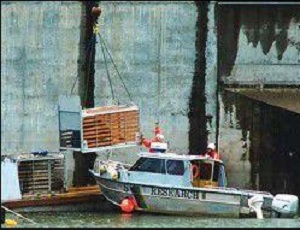
NOAA makes plans for sea lion control
NOAA Fisheries has released a draft plan for public comment to remove and kill as many as 416 California and Steller sea lions each year in a 180 mile stretch of the Columbia River from just downstream of Bonneville Dam at river mile 112 upstream to McNary Dam at river mile 292.,,, Addressing sea lion predation is part of a comprehensive salmon and steelhead recovery strategy, NOAA says. ,,,“This action is intended to reduce or eliminate sea lion predation on the fishery stocks that are listed as threatened or endangered under the Endangered Species Act of 1973,” >click to read< 11:48
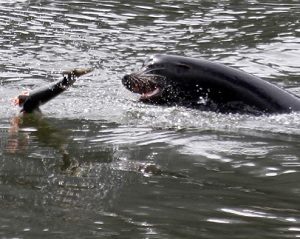
Proposal would kill more sea lions to protect fish
More than 1,100 sea lions could be killed annually along a stretch of the Columbia River on the Oregon-Washington border to boost faltering populations of salmon and steelhead, federal officials said Friday. The National Marine Fisheries Service said it’s taking public comments through Oct. 29 on the plan requested by Idaho, Oregon, Washington, and Native American tribes. The agency says billions of dollars on habitat restoration, fish passage at dams and other efforts have been spent in the three states in the last several decades to save 13 species of Columbia Basin salmon and steelhead protected under the Endangered Species Act. >click to read< 13:43
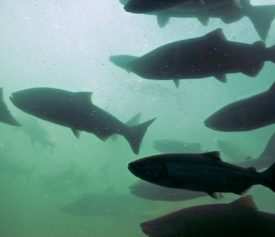
Opinion: Why Bonneville can’t save salmon
The Northwest is not winning the battle to save wild salmon and steelhead in the Columbia River. Although most of the 12 listed salmonid stocks in the basin demonstrated a weak upward trend for a couple decades, that progress has stalled. Total returns of salmon and steelhead passing Bonneville Dam last year slipped to the second-lowest level in the past 18 years, and spring Chinook returns were 60 percent of the 10-year average. by Tom Karier >click to read<10:34
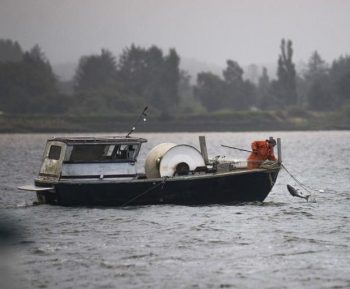
Lower Columbia River mainstem commercial gillnet fishing ; Non-treaty gillnetters get 45 hours through Aug. 29
With less than half of the 10-year average of fall Chinook salmon expected to return to the Columbia River this year, the two-state Columbia River Compact opened commercial gillnetting in the lower river and in pools upstream of Bonneville Dam for treaty commercial gillnetting.,,, The Compact met this week, Monday, Aug. 12, at the Washington Department of Fish and Wildlife’s regional office in Ridgefield to consider early fall Chinook mainstem gillnetting, deciding on 5 nine-hour overnight periods, for a 45-hour total for commercial non-treaty gillnetters beginning Aug. 14 and ending Aug. 29. >click to read< 16:34
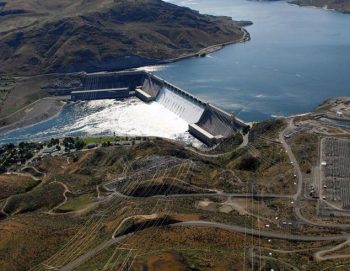
Report: Fish passage above the Columbia’s biggest dam can be done
It’s been nearly 80 years since salmon and steelhead made it past Chief Joseph and Grand Coulee dams in Washington’s Upper Columbia Basin.,, A team of researchers presented their findings on Tuesday to the Northwest Power and Conservation Council. In short, they said, salmon can survive in the upper reaches of the Columbia Basin, and fish passage needs to happen at the two dams. For several years biologists have looked into scenarios for salmon above the dams — if there was enough habitat available, if pathogens and predators wouldn’t cause too much damage, if there were even ways to get the fish around the concrete structures. >click to read<09:11






